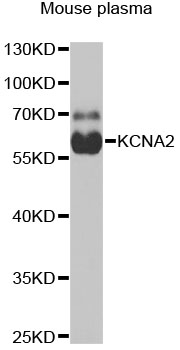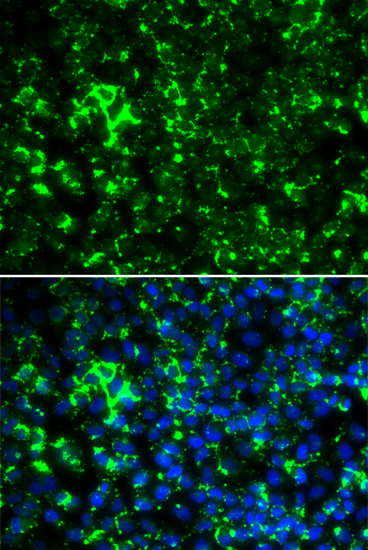Signal Transduction Antibodies 3
Anti-KCNA2 Antibody (CAB6295)
- SKU:
- CAB6295
- Product Type:
- Antibody
- Reactivity:
- Human
- Reactivity:
- Mouse
- Host Species:
- Rabbit
- Isotype:
- IgG
- Antibody Type:
- Polyclonal Antibody
- Research Area:
- Signal Transduction
Description
| Antibody Name: | Anti-KCNA2 Antibody |
| Antibody SKU: | CAB6295 |
| Antibody Size: | 20uL, 50uL, 100uL |
| Application: | WB IF |
| Reactivity: | Human, Mouse |
| Host Species: | Rabbit |
| Immunogen: | Recombinant fusion protein containing a sequence corresponding to amino acids 1-165 of human KCNA2 (NP_001191198.1). |
| Application: | WB IF |
| Recommended Dilution: | WB 1:500 - 1:2000 IF 1:50 - 1:100 |
| Reactivity: | Human, Mouse |
| Positive Samples: | Mouse plasma |
| Immunogen: | Recombinant fusion protein containing a sequence corresponding to amino acids 1-165 of human KCNA2 (NP_001191198.1). |
| Purification Method: | Affinity purification |
| Storage Buffer: | Store at -20'C. Avoid freeze / thaw cycles. Buffer: PBS with 0.02% sodium azide, 50% glycerol, pH7.3. |
| Isotype: | IgG |
| Sequence: | MTVA TGDP ADEA AALP GHPQ DTYD PEAD HECC ERVV INIS GLRF ETQL KTLA QFPE TLLG DPKK RMRY FDPL RNEY FFDR NRPS FDAI LYYY QSGG RLRR PVNV PLDI FSEE IRFY ELGE EAME MFRE DEGY IKEE ERPL PENE FQRQ VWLL FEYP ESSG PARI I |
| Gene ID: | 3737 |
| Uniprot: | P16389 |
| Cellular Location: | Cell junction, Cell membrane, Cell projection, Endoplasmic reticulum membrane, Membrane, Multi-pass membrane protein, axon, dendrite, lamellipodium membrane, presynaptic cell membrane, synapse, synaptosome |
| Calculated MW: | 40kDa/56kDa |
| Observed MW: | 60kDa |
| Synonyms: | KCNA2, EIEE32, HBK5, HK4, HUKIV, KV1.2, MK2, NGK1, RBK2 |
| Background: | Potassium channels represent the most complex class of voltage-gated ion channels from both functional and structural standpoints. Their diverse functions include regulating neurotransmitter release, heart rate, insulin secretion, neuronal excitability, epithelial electrolyte transport, smooth muscle contraction, and cell volume. Four sequence-related potassium channel genes - shaker, shaw, shab, and shal - have been identified in Drosophila, and each has been shown to have human homolog(s). This gene encodes a member of the potassium channel, voltage-gated, shaker-related subfamily. This member contains six membrane-spanning domains with a shaker-type repeat in the fourth segment. It belongs to the delayed rectifier class, members of which allow nerve cells to efficiently repolarize following an action potential. The coding region of this gene is intronless, and the gene is clustered with genes KCNA3 and KCNA10 on chromosome 1. |
| UniProt Protein Function: | Kv1.2: Mediates the voltage-dependent potassium ion permeability of excitable membranes. Assuming opened or closed conformations in response to the voltage difference across the membrane, the protein forms a potassium-selective channel through which potassium ions may pass in accordance with their electrochemical gradient. Belongs to the potassium channel family. A (Shaker) (TC 1.A.1.2) subfamily. Kv1.2/KCNA2 sub-subfamily. 2 isoforms of the human protein are produced by alternative splicing. |
| UniProt Protein Details: | Protein type:Channel, potassium; Membrane protein, integral; Membrane protein, multi-pass Chromosomal Location of Human Ortholog: 1p13 Cellular Component: presynaptic membrane; voltage-gated potassium channel complex; endoplasmic reticulum membrane; integral to plasma membrane; lamellipodium; axon; dendrite; integral to membrane; plasma membrane; perikaryon; nerve terminal; cell junction Molecular Function:voltage-gated potassium channel activity; potassium channel activity; delayed rectifier potassium channel activity; outward rectifier potassium channel activity Biological Process: synaptic transmission; optic nerve structural organization; generation of action potential; sensory perception of pain; regulation of dopamine secretion; potassium ion transport; protein homooligomerization Disease: Epileptic Encephalopathy, Early Infantile, 32 |
| NCBI Summary: | Potassium channels represent the most complex class of voltage-gated ion channels from both functional and structural standpoints. Their diverse functions include regulating neurotransmitter release, heart rate, insulin secretion, neuronal excitability, epithelial electrolyte transport, smooth muscle contraction, and cell volume. Four sequence-related potassium channel genes - shaker, shaw, shab, and shal - have been identified in Drosophila, and each has been shown to have human homolog(s). This gene encodes a member of the potassium channel, voltage-gated, shaker-related subfamily. This member contains six membrane-spanning domains with a shaker-type repeat in the fourth segment. It belongs to the delayed rectifier class, members of which allow nerve cells to efficiently repolarize following an action potential. The coding region of this gene is intronless, and the gene is clustered with genes KCNA3 and KCNA10 on chromosome 1. [provided by RefSeq, Jul 2008] |
| UniProt Code: | P16389 |
| NCBI GenInfo Identifier: | 1345813 |
| NCBI Gene ID: | 3737 |
| NCBI Accession: | P16389.2 |
| UniProt Secondary Accession: | P16389,Q86XG6, A0A024R0D3, A8K1Z6, |
| UniProt Related Accession: | P16389 |
| Molecular Weight: | 499 |
| NCBI Full Name: | Potassium voltage-gated channel subfamily A member 2 |
| NCBI Synonym Full Names: | potassium voltage-gated channel, shaker-related subfamily, member 2 |
| NCBI Official Symbol: | KCNA2 |
| NCBI Official Synonym Symbols: | HK4; MK2; HBK5; NGK1; RBK2; HUKIV; KV1.2 |
| NCBI Protein Information: | potassium voltage-gated channel subfamily A member 2; voltage-gated K(+) channel HuKIV; voltage-gated potassium channel HBK5; voltage-gated potassium channel protein Kv1.2; voltage-gated potassium channel subunit Kv1.2 |
| UniProt Protein Name: | Potassium voltage-gated channel subfamily A member 2 |
| UniProt Synonym Protein Names: | NGK1Voltage-gated K(+) channel HuKIV |
| Protein Family: | Potassium voltage-gated channel subfamily |
| UniProt Gene Name: | KCNA2 |
| UniProt Entry Name: | KCNA2_HUMAN |








